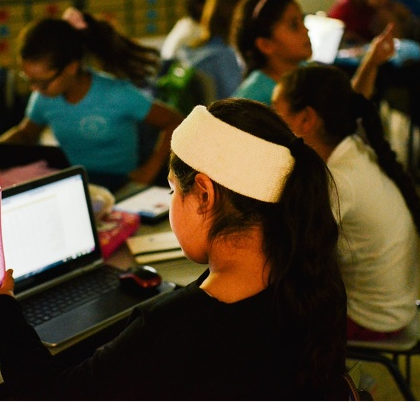Home > Oasis of Peace > Projects & Outreach > Children’s Educational System > The Primary School in 2016-2017
The Primary School in 2016-2017
Thursday 15 December 2016

How to provide binational, bilingual quality education while keeping the costs of tuition fees low enough to attract diverse socio-economic groups? This is the question with which we have been attempting to address from the very beginning.
One of our responses is growth. On September 1, the new school year opened with 32 Kindergartners and two new 1st grade classes. With an enrolment of 198 children in 8 classes, the school had grown by almost 25% over the previous school year, which in turn was up from the previous year - (46% for the two years).
A bilingual school cannot cope with a significant number of new children in higher grades - and there is also a natural drop off rate as some children will move houses and schools. So the answer is to boost the number of children coming into first grade. With recruitment efforts and word-of-mouth advocacy the demand is there. But how to fund that?
As the school grows, it requires expansion in the number of teaching hours. This year the number jumped from 339 to 416. But only 41% of these are covered by the state. The rest must be funded from private sources (parents fees and donor contributions).
In order to overcome a shortfall and limit pressure on parents and donors, we try to find ways to tweak and raise the state’s allocation. This has involved intensive work by the school staff, the community and parents.
The process began several years ago when the community decided to ask the Education Ministry to accept the School as an official state school (rather than a recognized independent school). This was not a step that the school and the community took lightly. After all, we had had that status before, and experienced problems around the issue of "ownership" of the school, its curriculum and future development. In Israel there is no ideal category for a mixed status of Jewish - Arab school in Israel. Schools must be either "Arab" or "Jewish". Yet most of the (few) other bilingual schools in Israel have opted to be state schools: and for good reason: the status guarantees a higher allocation.
The transition back to being a state school proved to be bumpy. We had to deal with slow bureaucracy and funding delays besides internal challenges. Working on the transition and seeking avenues to new state funding took much time and effort during the 2015 - 2016 school year. But now it’s in place and the school is functioning as a full state school.
Beyond the official school designation, we have also been struggling to enter several other categories - those of "special school", "extra-regional school" and "experimental school". Our school was the only one in the precinct of our regional council to apply for the latter, for the field of innovation. We will speak more about each of these in a future newsletter. Our design behind these efforts are to respond to our need of providing quality education at an affordable rate for parents, while enhancing the school’s prestige as a leader in Jewish - Arab education.
Curriculum Development
One of our current efforts has been to produce a fully documented syllabus for teaching in a bilingual binational school environment. This is a work in progress (and something that we have been working on for many years).
Our intention is to introduce a semi-formal teaching framework for the various cultures, languages and national identities of the people of the region. Eventually, this will help us to spread this curricula to other schools. A focus of the school staff this school year is to build a model for language education, looking at the best ways to integrate the bilingual educational goals into the school’s every day life. Finally this year we hope to strengthen the schools music program and build a more formal structure for music and arts education. Our progress in this depends very much on obtaining dedicated funds. However what we have been able to produce so far already goes a long way towards streamlining our teaching methodology in key subjects.